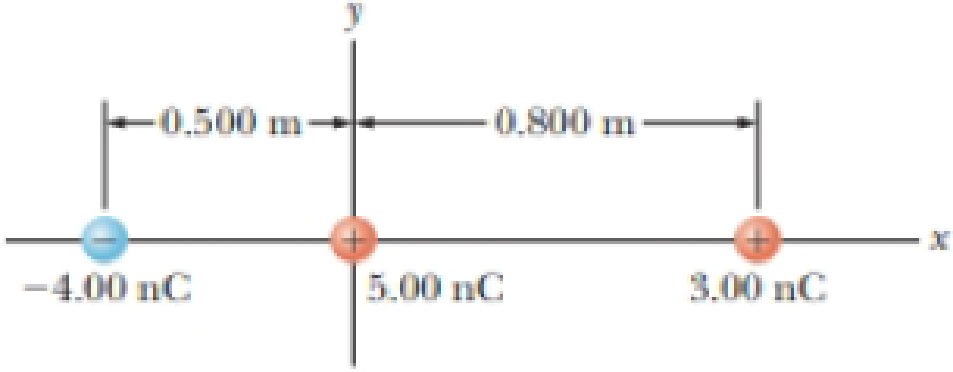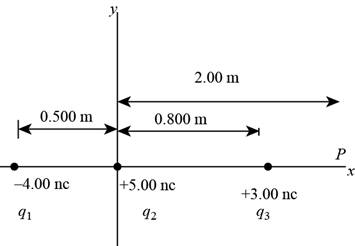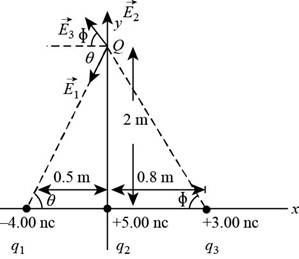
Concept explainers
Three charged particles are aligned along the x axis as shown in Figure P22.35. Find the electric field at (a) the position (2.00 m, 0) and (b) the position (0, 2.00 m).
Figure P22.35

(a)
The electric field at the position
Answer to Problem 35AP
The electric field at the position
Explanation of Solution
Given Info: Three charges are acting on the same line along the
According to Coulomb’s law, the electric field created by a charge
Here,
The electric field at a point due to number of charges is resultant of the electric field due to the individual charges.
The figure for the position of point charges is shown below.

Figure (1)
The electric field due to charge
Here,
Substitute
The electric field due to charge
Here,
Substitute
The electric field due to charge
Here,
Substitute
The resultant electric field can be given as,
Here,
Substitute
Thus, the electric field at position
Conclusion:
Therefore, the electric field at the position
(b)
The electric field at the position
Answer to Problem 35AP
The electric field at the position
Explanation of Solution
Given Info: Three charges are acting on the same line along the
The figure for the position of point charges is shown below,

Figure (2)
According to Pythagoras theorem, the distance between the charge
Here,
According to Pythagoras theorem, the distance between the charge
Here,
The electric field due to charge
Here,
Substitute
In component form the electric field can be written as,
According to right angle triangle property,
And,
Substitute
The electric field due to charge
Here,
Substitute
The electric field due to charge
Here,
Substitute
In component form the electric field can be written as,
According to right angle triangle property,
And,
Substitute
The resultant electric field can be given as,
Here,
Substitute
Thus, the electric field at position
Conclusion:
Therefore, the electric field at position
Want to see more full solutions like this?
Chapter 22 Solutions
Bundle: Physics For Scientists And Engineers With Modern Physics, 10th + Webassign Printed Access Card For Serway/jewett's Physics For Scientists And Engineers, 10th, Multi-term
Additional Science Textbook Solutions
Physics: Principles with Applications
University Physics Volume 2
Tutorials in Introductory Physics
Schaum's Outline of College Physics, Twelfth Edition (Schaum's Outlines)
Lecture- Tutorials for Introductory Astronomy
- In Figure P24.49, a charged particle of mass m = 4.00 g and charge q = 0.250 C is suspended in static equilibrium at the end of an insulating thread that hangs from a very long, charged, thin rod. The thread is 12.0 cm long and makes an angle of 35.0 with the vertical. Determine the linear charge density of the rod. FIGURE P24.49arrow_forwardaA plastic rod of length = 24.0 cm is uniformly charged with a total charge of +12.0 C. The rod is formed into a semicircle with its center at the origin of the xy plane (Fig. P24.34). What are the magnitude and direction of the electric field at the origin? Figure P24.34arrow_forwardA uniform electric field given by E=(2.655.35j)105N/C permeates a region of space in which a small negatively charged sphere of mass 1.30 g is suspended by a light cord (Fig. P24.53). The sphere is found to be in equilibrium when the string makes an angle = 23.0. a. What is the charge on the sphere? b. What is the magnitude of the tension in the cord? FIGURE P24.53arrow_forward
- Figure P24.51 shows four small charged spheres arranged at the corners of a square with side d = 25.0 cm. a. What is the electric field at the location of the sphere with charge +2.00 nC? b. What is the total electric force exerted on the sphere with charge +2.00 nC by the other three spheres? FIGURE P24.51arrow_forwardFigure P24.16 shows three charged particles arranged in the xy plane at the coordinates shown, with qA = qB = 3.30 nC and qC = 4.70 nC. What is the electric field due to these particles at the origin? FIGURE P24.16arrow_forwardFind an expression for the magnitude of the electric field at point A mid-way between the two rings of radius R shown in Figure P24.30. The ring on the left has a uniform charge q1 and the ring on the right has a uniform charge q2. The rings are separated by distance d. Assume the positive x axis points to the right, through the center of the rings. FIGURE P24.30 Problems 30 and 31.arrow_forward
- A circular ring of charge with radius b has total charge q uniformly distributed around it. What is the magnitude of the electric field at the center of the ring? (a) 0 (b) keq/b2 (c) keq2/b2 (d) keq2/b (e) none of those answersarrow_forwardTwo long, thin rods each have linear charge density = 6.0 C/m and lie parallel to each other, separated by 20.0 cm as shown in Figure P25.32. Determine the magnitude and direction of the net electric field at point P, a distance of 15.0 cm directly above the right rod. Figure P25.32arrow_forwardThree charged particles are aligned along the x axis as shown in Figure P22.35. Find the electric field at (a) the position (2.00 m, 0) and (b) the position (0, 2.00 m). Figure P22.35arrow_forward
- Three identical charges (q = 5.0 C.) lie along a circle of radius 2.0 m at angles of 30, 150, and 270, as shown in Figure P15.33 (page 524). What is the resultant electric field at the center of the circle? Figure P15.33arrow_forwardEight small conducting spheres with identical charge q = 2.00 C are placed at the corners of a cube of side d = 0.500 m (Fig. P23.75). What is the total force on the sphere at the origin (sphere A) due to the other seven spheres? Figure P23.75arrow_forwardA charged cork ball of mass m is suspended on a light string in the presence of a uniform electric field as shown in Figure P22.33. When E=Ai+Bj, where A and B are positive quantities, the ball is in equilibrium at the angle . Find (a) the charge on the ball and (b) the tension in the string. Figure P22.33 Problems 33 and 34arrow_forward
 Physics for Scientists and EngineersPhysicsISBN:9781337553278Author:Raymond A. Serway, John W. JewettPublisher:Cengage Learning
Physics for Scientists and EngineersPhysicsISBN:9781337553278Author:Raymond A. Serway, John W. JewettPublisher:Cengage Learning Physics for Scientists and Engineers with Modern ...PhysicsISBN:9781337553292Author:Raymond A. Serway, John W. JewettPublisher:Cengage Learning
Physics for Scientists and Engineers with Modern ...PhysicsISBN:9781337553292Author:Raymond A. Serway, John W. JewettPublisher:Cengage Learning Physics for Scientists and Engineers: Foundations...PhysicsISBN:9781133939146Author:Katz, Debora M.Publisher:Cengage Learning
Physics for Scientists and Engineers: Foundations...PhysicsISBN:9781133939146Author:Katz, Debora M.Publisher:Cengage Learning College PhysicsPhysicsISBN:9781305952300Author:Raymond A. Serway, Chris VuillePublisher:Cengage Learning
College PhysicsPhysicsISBN:9781305952300Author:Raymond A. Serway, Chris VuillePublisher:Cengage Learning College PhysicsPhysicsISBN:9781285737027Author:Raymond A. Serway, Chris VuillePublisher:Cengage Learning
College PhysicsPhysicsISBN:9781285737027Author:Raymond A. Serway, Chris VuillePublisher:Cengage Learning Principles of Physics: A Calculus-Based TextPhysicsISBN:9781133104261Author:Raymond A. Serway, John W. JewettPublisher:Cengage Learning
Principles of Physics: A Calculus-Based TextPhysicsISBN:9781133104261Author:Raymond A. Serway, John W. JewettPublisher:Cengage Learning





